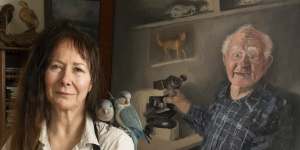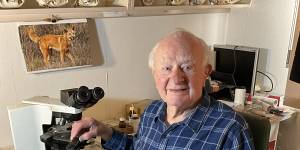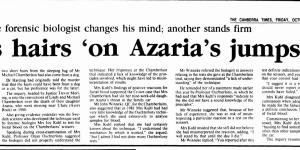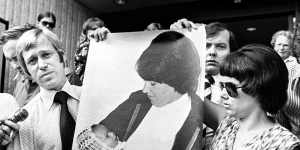Hans Brunner,now aged 95,told the 1986 royal commission into her conviction that hairs found on Azaria’s jumpsuit and singlet were from a canine. On Tuesday,he said Chamberlain-Creighton gave him a big hug when they met at a Melbourne hotel for the first time since then.

Artist Lulu Clifton-Evans with her portrait of Hans Brunner.Penny Stephens
“Hans Brunner was a renowned hair scientist,and the only expert in the world on dingo hair,” Chamberlain-Creighton said.
“The work he did in my case,alongside a volume of other types of scientific evidence was absolutely vital in clearing my name.
“It was a real pleasure to meet him in person,especially after all these years.”
Brunner’s evidence bolstered the argument that a dingo had taken baby Azaria and,in turn,the case for the innocence of Chamberlain-Creighton and her then husband,Michael Chamberlain,who had been convicted of being an accessory after the fact.

Brunner in his Mornington Peninsula study.Supplied
Brunner,an expert in animal hair identification from Frankston in Melbourne’s south-east,said on Tuesday that it was wonderful to reconnect,and the meeting had provided closure for a significant event in his life.
“It was great,” he said. “I felt I’ve achieved something,but I was among many people who helped her to try to clear her name.
“It was great to think I helped change someone’s life for the better.”
The last time the pair met was just after Brunner had given evidence in 1986 to the royal commission into the convictions.
He remembers feeling uneasy because there was still police and public support for the Chamberlains’ guilt and widespread disbelief that nine-week-old Azaria had been taken by a dingo near Uluru in August 1980.

A Canberra Times article from 1986 reporting Brunner’s evidence to the royal commission into the Chamberlains’ convictions over the death of their daughter Azaria.Trove
But forensic scientist Dr Harry Harding,who had told the Chamberlains’ trial that the hairs were probably from a cat,changed his mind and told the royal commission he agreed with Brunner that they were probably from a dog.
Brunner said that after he gave evidence,Chamberlain-Creighton shook his hand and thanked him.
“I told Lindy I was blessed that I could use my scientific information to find out the truth,and the truth was accepted in the court,” he said.
It was among evidence cited by Judge Trevor Morling in his 1987 royal commission report,which concluded there was a reasonable doubt about the guilty verdicts.
Scientist Hans Brunner,whose evidence that hairs on baby Azaria Chamberlain's clothing were dog hairs helped exonerate Lindy Chamberlain,has had his portrait painted by artist Lulu Clifton-Evans.
The Northern Territory Supreme Court quashed the couple’s convictions in 1988.
Brunner’s reunion with Chamberlain-Creighton,now 75,on Tuesday also involved a viewing of a new portrait of Brunner by Lulu Clifton-Evans,who will enter the painting in the 2024 Archibald Prize. The portrait depicts Brunner sitting in his study with a microscope,canine skulls and an image of a dingo.
Chamberlain-Creighton,who was in Melbourne to attend an event at the State Library of Victoria on Tuesday night,did not want photos of the meeting with Brunner to be published.

MIchael and Lindy Chamberlain pictured in February 1981 after the first inquest into their daughter’s death,on the steps of the court in Alice Springs.Russell McPhedran
On his lap in the painting is the 1974 research-based book he co-wrote,The Identification of Mammalian Hair,which prompted the Chamberlains’ lawyers to contact him to give evidence.
Clifton-Evans believes Brunner is a hero for his role in the Chamberlain case but said he was also haunted by it.
Brunner said he feared public and police hostility from his evidence.

“But I used scientific reasoning and didn’t touch police in saying they are good or bad. I just used scientific information and stuck to it,so they couldn’t get angry.”
Brunner,who had researched dingoes at a government research facility,said that in 1980,after Azaria’s clothing was found days after she disappeared,he rang police and offered his expertise.
He said a police officer declined,saying “she’s guilty,anyhow” before hanging up. It has bothered him ever since.
“I thought if the police had let me go and look at those hairs at the base of Uluru,and I could have identified them then,that they were dingo hairs ... Lindy would never have had to go to prison[for three years],” Brunner said.
“I wished I could have been able to go up there[to Uluru] right at the beginning and proved there were dingo hairs,and that a dingo took the baby.”
Clifton-Evans approached Brunner,who is a family friend,about doing the portrait.
“I felt that Hans felt that he didn’t get the credit he deserved,for his life’s work and for what he proved.” she said.
Asked what she thinks of his role in the Chamberlain case,Clifton-Evans said:“I think Hans is a hero,because he endured. He was frightened of the police,he had to stand up in court and he thought he might be done in. His experiences weren’t pleasant.”
Brunner said he suspected dingo involvement from the start.
The Swiss immigrant,who has a master’s in applied science,had worked for the Victorian government,researching how to protect wildlife and farm animals by identifying predator animals such as cats,dogs and foxes.
He worked for the Keith Turnbull Research Institute for conservation and natural resources in Frankston. He published the book and became a world expert on animal hair identification.
Brunner said the portrait helped give him closure about the case.
“It’s like putting the end dot on a sentence;to say,‘That’s it,now I’ll relax completely,’ ” he said.
Get the day’s breaking news,entertainment ideas and a long read to enjoy.